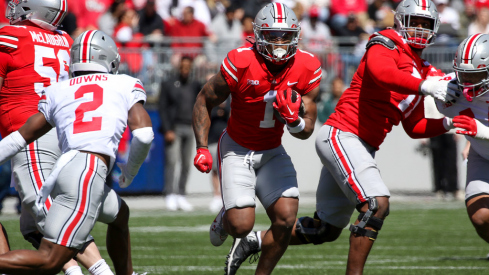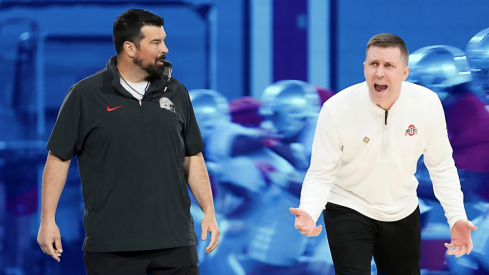Ohio State baseball is on a quest for national relevance. An enthusiasm gap is holding it back.
Great things were not expected of Ohio State baseball in 2014.
One preseason poll ranked the Buckeyes 105th in the country and 7th in the Big Ten. Big Ten coaches were more generous, predicting Ohio State to finish third in the conference, but either way the Buckeyes were an afterthought in the national race.
As a result, beginning the 2014 season with the Snowbird Classic in Port Charlotte, Fla. looked like a mistake. Ohio State's three opponents received votes in preseason polls, and coach Greg Beals didn't sound all that confident either:
“It’s going to be interesting,” Beals said. “We lost nine seniors and our entire rotation, so there are a lot of new guys in the mix. There will be growing pains — especially with the caliber of schedule. I believe come conference play these freshmen will be ready. I’m more than comfortable with this baseball team.”
An 0-4 start appeared likely; against all expectations, the Buckeyes are 2-1 heading into Sunday.
First, the Buckeyes' bats came to life in an 8-2 win against Connecticut. Jacob Bosiokovic hit a grand slam in the third inning to give Ohio State a 4-2 lead, and RBI hits from Craig Nenning, Troy Kuhn, and Tim Wetzel extended the lead. Freshman Travis Lakins came out of the bullpen to close the game with three shutout innings.
The Buckeyes followed that up by blanking Auburn 1-0. Josh Dezse singled in the game's only run in the fourth inning, and Ryan Riga, Tyler Giannonatti and Trace Dempsey combined for a five hit shutout.
The Buckeyes dropped their first game of the season to Indiana State a few hours later, 7-3. Should Ohio State beat the Sycamores in a rematch on Sunday, they might receive votes in the national polls.
Considering preseason expectations, Ohio State is off to a great start. So why don't more people care about the baseball team?
The Buckeyes have several players marked for national success, namely preseason all-American candidates Josh Dezse and Trace Dempsey. The Buckeyes went 35-23 last year, and came within three outs of a regular season Big Ten title. And yet, all the attention is on men's basketball and hockey.
The Big Ten's decades-long impotence bears some blame for that. Until Indiana made the College World Series last year, no Big Ten team had done so since Michigan in 1984. The Big Ten is trying to become more nationally relevant by linking to the East Coast:
"We're so much more sensitive to working at this," Delany said. "We want to get people to adopt the Big Ten. That means come to New York, play games in DC, play games at [Madison Square] Garden -- play, live and build on a broader scale. It's where you recruit students, where you play bowl games, where your television games go.
"We have 30 percent of the population, 15 percent of the territory, but we're not constrained to that. We have a national look."
...but that's not where baseball success comes from. It comes from the Sun Belt.
In the Sun Belt, baseball is held up alongside football and men's basketball as a revenue sport. Texas baseball had revenues of nearly $7 million in 2011-2012 and profits over $4 million. That represents 4.7% of Texas athletics’ revenue, a far greater share than Ohio State earns from baseball.
Attendance numbers show the enthusiasm gap as well. Ohio State averaged only 1,128 fans per home game last year. By contrast, Texas averaged 5,793 fans per game. LSU saw 472,391 fans come through its gates, 10,736 per game. That's over nine times as many fans than came to see Ohio State.
Although Bill Davis Stadium does not draw crowds like Texas or LSU, there ought to be more enthusiasm in Ohio for a winning program. The Buckeyes were consistent winners under Bob Todd, but the lack of tournament success should have left fans hungry. The Buckeyes haven't made an NCAA tournament since 2009, or a super regional since 2003, or a College World Series since the 1960s.
The popularity of the Reds, Indians, and Clippers shows that Buckeye baseball has the potential fan base to succeed. Nick Swisher's MLB success shows that Ohio State can recruit elite players. So why isn't Ohio State an elite program?
To be sure, the early start date of the season hurts the program. The NCAA is cowed by Sun Belt baseball schools, which insist the regular season begins in mid-February or earlier. After all, what says regular season baseball like Valentine's Day, or playing in the Grapefruit League while 49 of 50 states have snow on the ground?
Southern and western schools refuse to play in the north early in the season, meaning that northern teams either have to schedule other northern teams and weaken their RPI, or spend the first month of the season on the road... and weaken their RPI.
So yes, playing no home games until mid-March sucks, as does the NCAA's refusal to allow creative solutions to the imbalance. But that doesn’t mean we ought to use that as a crutch. Ohio State and the rest of the Big Ten have the resources to invest in baseball, and the recent achievements of Purdue and Indiana show Big Ten teams can succeed. With the Big Ten Network to distribute games nationally, the whole Big Ten could get good at baseball someday.
For now, these dreams of national relevance are building castles in the sky. Ohio State will face a bevy of neutral and road games before the first home stand against Siena on March 14. It could use some support on opening day for what looks like one heck of a team.

